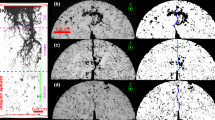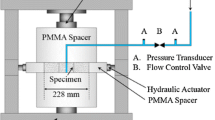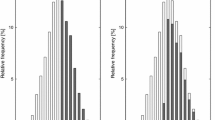Abstract
Fractures in wellbore cement and along wellbore-cement/host-rock interfaces have been identified as potential leakage pathways from long-term carbon sequestration sites. When exposed to carbon-dioxide-rich brines, the alkaline cement undergoes a series of reactions that form distinctive fronts adjacent to the cement surface. However, quantifying the effect of these reactions on fracture permeability is not solely a question of geochemistry, as the reaction zones also change the cement’s mechanical properties, modifying the fracture geometry as a result.This paper describes how these geochemical and geomechanical processes affect fracture permeability in wellbore cement. These competing influences are discussed in light of data from a core-flood experiment conducted under carbon sequestration conditions: reaction chemistry, fracture permeability evolution over time, and comparative analysis of X-ray tomography of unreacted and reacted cement samples. These results are also compared to predictions by a complementary numerical study that couples geochemical, geomechanical and hydrodynamic simulations to model the formation of reaction fronts within the cement and their effect on fracture permeability.











Similar content being viewed by others
References
Adrian R (2005) Twenty years of particle image velocimetry. Exp Fluids 39(2):159–169
Agbasimalo N, Radonjic M (2012) Experimental study of portland cement/rock interface in relation to wellbore stability for carbon capture and storage (ccs). In: The 46th US Rock Mechanics Symposium, Chicago, IL, ARMA 12, pp ARMA 12–437
Buhmann D, Dreybrodt W (1985a) The kinetics of calcite dissolution and precipitation in geologically relevant situations of karst areas : 1. Open system. Chem Geol 48(1–4):189–211
Buhmann D, Dreybrodt W (1985b) The kinetics of calcite dissolution and precipitation in geologically relevant situations of karst areas : 2. Closed system. Chem Geol 53(1–2):109–124
Carey JW, Wigand M, Chipera SJ, WoldeGabriel G, Pawar R, Lichtner PC, Wehner SC, Raines MA, Guthrie GD, Jr (2007) Analysis and performance of oil well cement with 30 years of CO2 exposure from the SACROC Unit, West Texas, USA. Int J Greenh Gas Con 1(1):75–85. doi:10.1016/S1750-5836(06)00004-1, 8th International Conference on Greenhouse Gas Control Technologies—GHGT-8
Carey JW, Svec R, Grigg R, Lichtner PC, Zhang J, Crow W (2009) Wellbore integrity and CO2 -brine flow along the casing-cement microannulus. Energy Procedia 1(1):3609–3615
Constantinides G, Ulm F (2004) The effect of two types of csh on the elasticity of cement-based materials: results from nanoindentation and micromechanical modeling. Cement Concrete Res 34(1):67–80
Dreybrodt W, Gabrovsek F, Romanov D (2005) Processes of speleogenesis: a modeling approach. Zalozba ZRC
Duguid A, Scherer GW (2010) Degradation of oilwell cement due to exposure to carbonated brine. Int J Greenh Gas Con 4(3):546–560. doi:10.1016/j.ijggc.2009.11.001
Duguid A, Radonjic M, Scherer G (2005) Degradation of well cement exposed to carbonated brine. In: Proceedings of the 4th annual conference on carbon capture and sequestration
Johnson S, Morris J (2009) Modeling hydraulic fracturing for carbon sequestration applications. In: The 43rd US Rock Mechanics Symposium and the 4th US-Canada Rock Mechanics Symposium, American Rock Mechanics Association, Asheville, pp ARMA 09–30
Kutchko BG, Strazisar BR, Dzombak DA, Lowry GV, Thaulow N (2007) Degradation of well cement by CO2 under geologic sequestration conditions. Environ Sci Technol 41(13):4787–4792. doi:10.1021/es062828c
Kutchko BG, Strazisar BR, Lowry GV, Dzombak DA, Thaulow N (2008) Rate of CO2 attack on hydrated class H well cement under geologic sequestration conditions. Environ Sci Technol 42(16):6237–6242. doi:10.1021/es800049r, pMID: 18767693
Lewis K, Zyvoloski G, Kelkar S, Carey JW (2012) Coupled stress and flow along interfaces in the wellbore environment in relation to CO2 sequestration. In: The 46th US rock mechanics symposium, Chicago, IL, ARMA 12, pp ARMA 12–437
Mainguy M, Ulm FJ (2001) Coupled diffusion-dissolution around a fracture channel: the solute congestion phenomenon. Transp Porous Med 45:479–495. doi:10.1023/A:1012096014084
Metz B, Davidson O, De Coninck H, Loos M, Meyer L (2005) IPCC special report on carbon dioxide capture and storage: Prepared by working group III of the intergovernmental panel on climate change. IPCC, Cambridge University Press, Cambridge, New York
Pawar R, Watson T, Gable C (2009) Numerical simulation of CO2 leakage through abandoned wells: model for an abandoned site with observed gas migration in Alberta, Canada. Energy Procedia 1(1):3625–3632
Raffel M, Willert C, Kompenhans J (1998) Particle image velocimetry: a practical guide (experimental fluid mechanics). Springer, Berlin
Scarano F, Riethmuller ML (1999) Iterative multigrid approach in PIV image processing with discrete window offset. Exp Fluids 26:513–523. doi:10.1007/s003480050318
Settgast R, Johnson S, Fu P, Walsh SDC, Ryerson F (2012) Simulation of hydraulic fracture networks in three dimensions. In: Proceedings, thirty-seventh workshop on geothermal reservoir engineering. Stanford University, Stanford, pp SGP–TR–194
Smith D, Scherer G, Anderson J (1995) Shrinkage during drying of silica gel. J Non-Cryst Solids 188(3):191–206. doi:10.1016/0022-3093(95)00187-5
Smith MM, Sholokhova Y, Hao Y, Carroll S (2012) Evaporite caprock integrity: an experimental study of reactive mineralogy and pore-scale heterogeneity during brine-CO2 exposure. Environ Sci Technol (in press). doi:10.1021/es3012723
Ulm FJ, Lemarchand E, Heukamp FH (2003) Elements of chemomechanics of calcium leaching of cement-based materials at different scales. Eng Fract Mech 70(7–8):871–889. doi:10.1016/S0013-7944(02)00155-8
Wigand M, Kaszuba JP, Carey JW, Hollis WK (2009) Geochemical effects of CO2 sequestration on fractured wellbore cement at the cement/caprock interface. Chem Geol 265(1–2):122–133. doi:10.1016/j.chemgeo.2009.04.008
Acknowledgments
We gratefully support for this work under the DOE National Energy Technology Laboratory, Project AA3030100. We would like to thank Larry Knauer and the California Well Sample Repository for the caprock samples used in our experiments. The Advanced Light Source is supported by the Director, Office of Basic Energy Sciences of the US Department of Energy under Contract N. DE-AC0-2-05CH11231. We thank Yelena Scholokhova for collecting and processing the tomography data and Alastair MacDowell and Dula Parkinson for their assistance at the beamline. We are also grateful to M. Smith for her assistance with the experiments, as well as D. Ruddle and S. Torres for their assistance in the preparation of sample cores. This manuscript was approved for release by LLNL with release number LLNL-JRNL-598999. This document was prepared as an account of work sponsored by an agency of the United States government. Neither the United States government nor Lawrence Livermore National Security, LLC, nor any of their employees make any warranty, expressed or implied, or assumes any legal liability or responsibility for the accuracy, completeness, or usefulness of any information, apparatus, product, or process disclosed, or represents that its use would not infringe privately owned rights. Reference herein to any specific commercial product, process, or service by trade name, trademark, manufacturer, or otherwise does not necessarily constitute or imply its endorsement, recommendation, or favoring by the United States government or Lawrence Livermore National Security, LLC. The views and opinions of authors expressed herein do not necessarily state or reflect those of the United States government or Lawrence Livermore National Security, LLC, and shall not be used for advertising or product endorsement purposes.
Author information
Authors and Affiliations
Corresponding author
Additional information
Prepared by LLNL under Contract DE-AC52-07NA27344.
Rights and permissions
About this article
Cite this article
Walsh, S.D.C., Du Frane, W.L., Mason, H.E. et al. Permeability of Wellbore-Cement Fractures Following Degradation by Carbonated Brine. Rock Mech Rock Eng 46, 455–464 (2013). https://doi.org/10.1007/s00603-012-0336-9
Received:
Accepted:
Published:
Issue Date:
DOI: https://doi.org/10.1007/s00603-012-0336-9




